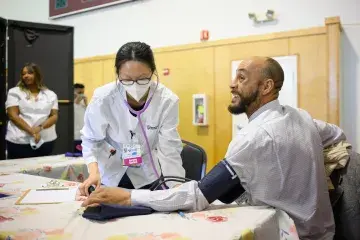Physical Therapy Students Learn From People With Parkinson’s Disease
An innovative initiative led by faculty and students in the Doctor of Physical Therapy program invites people with Parkinson’s disease into student-led labs on campus. There, students learn from local residents about what it’s like to have Parkinson’s, how it impacts their lives, and the challenges they face with diagnosis and mobility.
Students also provide pro bono services to community members with Parkinson’s by putting into practice the skills they’ve been taught in class. We asked Associate Professor Jason Hardage, DSc, DPT, who’s researching the benefits of incorporating yoga into Parkinson’s care, to fill us in.
Can you tell me about the PT department’s new Parkinson’s pilot initiative?
For this wellness program, we had eight community participants with Parkinson’s and about 14 PT students. The community participants received one-on-one attention and the students got the opportunity to apply the skills they learned in a real-world scenario.
What’s the goal of this pilot?
We believe this initiative supports the University’s mission to engage with the community and care for the underserved. On one hand, students receive hands-on opportunities to work with people with Parkinson’s, training they’ll take with them into their careers. On the other, it creates a partnership with the local Parkinson’s community that can be expanded and connects personally with community members who can benefit from the type of PT support our students can offer.
Why were you interested in having PT students work with people with Parkinson’s?
Like with many chronic health conditions, there’s research that shows that exercise is a key component to successfully managing the condition. One of the models we look to to serve people with Parkinson’s, from a rehab perspective, is called PRW—Parkinson’s Wellness Recovery. In this model, there’s an emphasis on the person with Parkinson’s establishing a care team that includes a physician and neurologist for the medical management, and also a physical therapist for the exercise component so that we can tailor the persons’ exercise prescription to their needs.
What connection do you see between Parkinson’s wellness and yoga?
My research focuses on using yoga as a framework for designing wellness programs for people with Parkinson’s. My interests are in using all of the different components of yoga. Yoga is understood in the East as the eight-fold path, of which asana, or the physical practice, is one component. In the West, we don’t hear as much about the other limbs, but each has applications for Parkinson’s patients, I believe. Another example is pranayama, or breathwork, which can be calming on one hand or energizing on the other. Breath training can be useful in helping to manage anxiety and apathy, two key features of Parkinson’s.
Have you presented your research to other physical therapists?
Last summer, I was honored to present an educational session at a national conference, NEXT, in Chicago. It was well received, with an overflow crowed a received a lot of positive feedback. I’m now working on a paper for a peer reviewed journal on the same topic with two SMU colleagues, Angela Rusher and Gail Widener.



